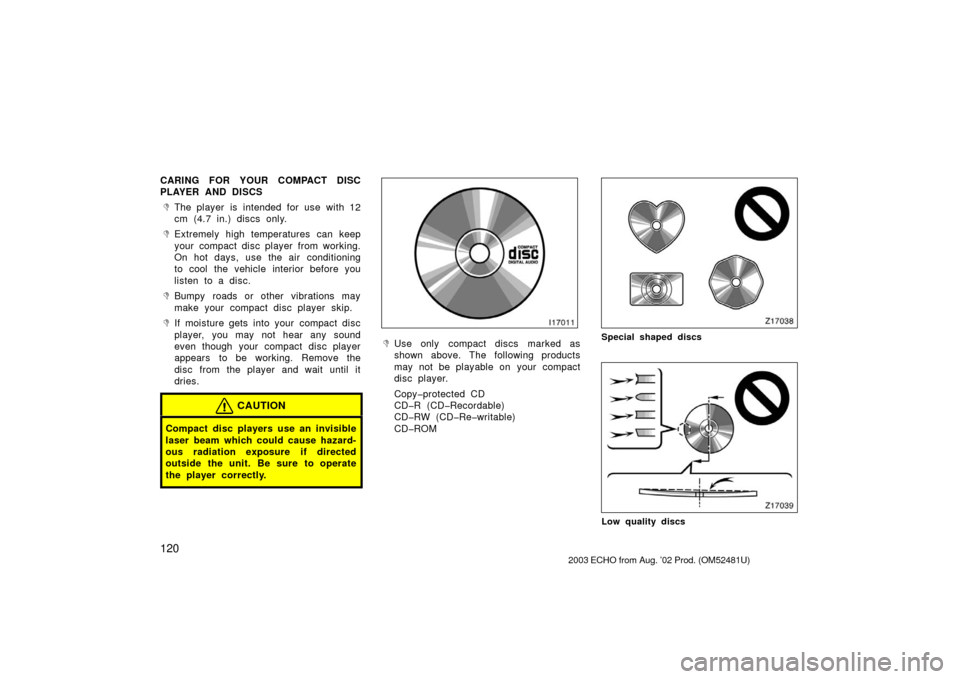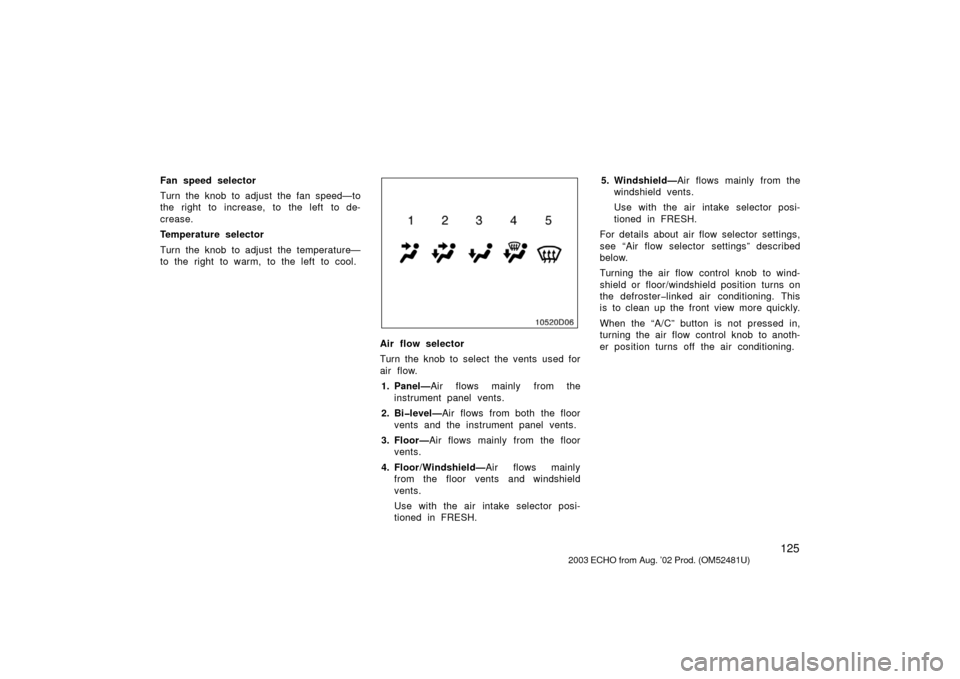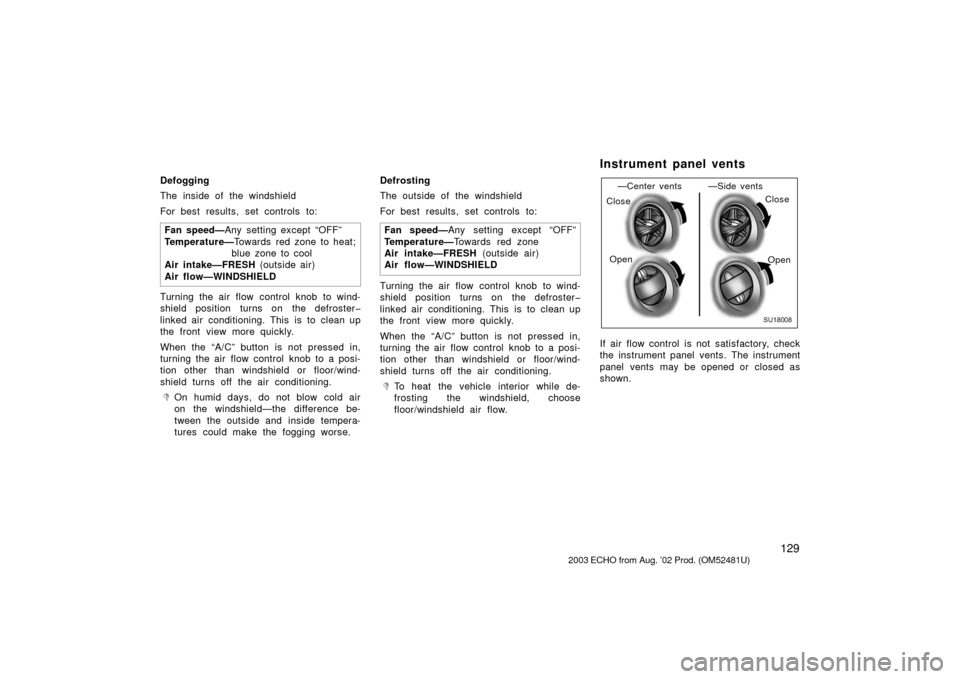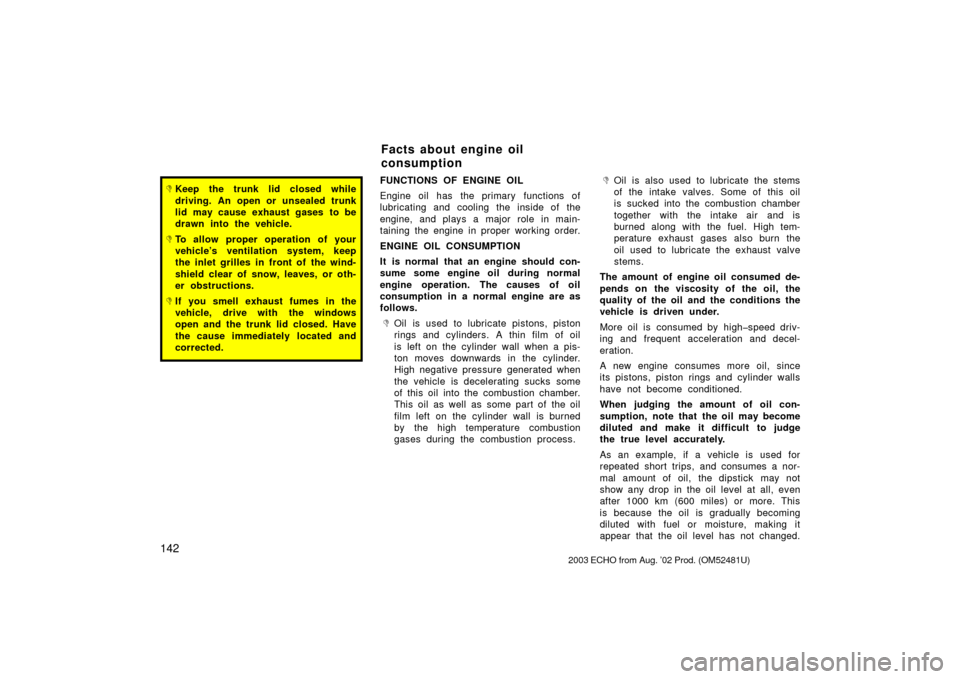Page 124 of 241

120
CARING FOR YOUR COMPACT DISC
PLAYER AND DISCS
�The player is intended for use with 12
cm (4.7 in.) discs only.
�Extremely high temperatures can keep
your compact disc player from working.
On hot days, use the air conditioning
to cool the vehicle interior before you
listen to a disc.
�Bumpy roads or other vibrations may
make your compact disc player skip.
�If moisture gets into your compact disc
player, you may not hear any sound
even though your compact disc player
appears to be working. Remove the
disc from the player and wait until it
dries.
CAUTION
Compact disc players use an invisible
laser beam which could cause hazard-
ous radiation exposure if directed
outside the unit. Be sure to operate
the player correctly.
�Use only compact discs marked as
shown above. The following products
may not be playable on your compact
disc player.
Copy�protected CD
CD�R (CD�Recordable)
CD�RW (CD�Re�writable)
CD�ROM
Z17038
Special shaped discs
Z17039
Low quality discs
2003 ECHO from Aug. ’02 Prod. (OM52481U)
Page 127 of 241
123
OPERATION OF INSTRUMENTS AND
CONTROLS
Air conditioning system
Controls124
. . . . . . . . . . . . . . . . . . . . . . . . . . . . . . . . . . . . .\
. . . . . . . . . . . . . .
Air flow selector settings 127
. . . . . . . . . . . . . . . . . . . . . . . . . . . . . . . . . . . . \
.
Operating tips 127
. . . . . . . . . . . . . . . . . . . . . . . . . . . . . . . . . . . . \
. . . . . . . . . .
Instrument panel vents 129
. . . . . . . . . . . . . . . . . . . . . . . . . . . . . . . . . . . . \
. .
2003 ECHO from Aug. ’02 Prod. (OM52481U)
SECTION 1� 8
Page 129 of 241

125
Fan speed selector
Turn the knob to adjust the fan speed—to
the right to increase, to the left to de-
crease.
Temperature selector
Turn the knob to adjust the temperature—
to the right to warm, to the left to cool.
Air flow selector
Turn the knob to select the vents used for
air flow.1. Panel— Air flows mainly from the
instrument panel vents.
2. Bi�level— Air flows from both the floor
vents and the instrument panel vents.
3. Floor— Air flows mainly from the floor
vents.
4. Floor/Windshield— Air flows mainly
from the floor vents and windshield
vents.
Use with the air intake selector posi-
tioned in FRESH. 5. Windshield—
Air flows mainly from the
windshield vents.
Use with the air intake selector posi-
tioned in FRESH.
For details about air flow selector settings,
see “Air flow selector settings” described
below.
Turning the air flow control knob to wind-
shield or floor/windshield position turns on
the defroster�linked air conditioning. This
is to clean up the front view more quickly.
When the “A/C” button is not pressed in,
turning the air flow control knob to anoth-
er position turns off the air conditioning.
2003 ECHO from Aug. ’02 Prod. (OM52481U)
Page 130 of 241
126
SZ18009
Air intake selector
Move the lever to select the air source.1. Recirculate— Recirculates the air inside
the vehicle.
2. Fresh— Draws outside air into the sys-
tem. “A/C” button
To turn on the air conditioning, press the
“A/C” button. The “A/C” button indicator
will come on. To turn the air conditioning
off, press the button again.
2003
ECHO from Aug. ’02 Prod. (OM52481U)
Page 131 of 241
127
Air flow selector settingsOperating tips
�To cool off your Toyota after it has
been parked in the hot sun, drive with
the windows open for a few minutes.
This vents the hot air, allowing the air
conditioning to cool the interior more
quickly.
�Make sure the air intake grilles in front
of the windshield are not blocked (by
leaves or snow, for example).
�On humid days, do not blow cold air
on the windshield. The windshield could
fog up because of the difference in air
temperature on the inside and outside
of the windshield.
�Keep the area under the front seats
clear to allow air to circulate through-
out the vehicle.
�On cold days, set the fan speed to
“high” for a minute to help clear the
intake ducts of snow or moisture. This
can reduce the amount of fogging on
the windows.
2003 ECHO from Aug. ’02 Prod. (OM52481U)
SU18005
Page 132 of 241

128�
When driving on dusty roads, close all
windows. If dust thrown up by the ve-
hicle is still drawn into the vehicle after
closing the windows, it is recommended
that the air intake selector be set to
FRESH and the fan speed selector to
any setting except “OFF”.
�If following another vehicle on a dusty
road, or driving in windy and dusty
conditions, it is recommended that the
air intake selector be temporarily set to
RECIRCULATED, which will close off
the outside passage and prevent out-
side air and dust from entering the
vehicle interior.
�When turning the temperature selector
fully to the left–“Max.cool” position,
cold air comes out from the center
vents in spite of the position of the air
flow selector.
Heating
For best results, set controls to:
Fan speed— Any setting except “OFF”
Temperature— Towards red zone
Air intake—FRESH (outside air)
Air flow—FLOOR
Air conditioning—OFF
�For quick heating, select recirculated
air for a few minutes. To keep the
windows from fogging, select fresh af-
ter the vehicle interior has been
warmed.
�Press the “A/C” button on for dehumidi-
fied heating.
�Choose floor/windshield air flow to heat
the vehicle interior while defrosting or
defogging the windshield. Air conditioning
For best results, set controls to:
Fan speed— Any setting except “OFF”
Temperature— To w a r d s blue zone
Air intake—FRESH (outside air)
Air flow—PANEL
Air conditioning—ON
�For quick cooling, move the air intake
selector to recirculate for a few min-
utes.
Ventilation
For best results, set controls to:
Fan speed— Any setting except “OFF”
Temperature— Towards blue zone
Air intake—FRESH (outside air)
Air flow—PANEL
Air conditioning—OFF
2003 ECHO from Aug. ’02 Prod. (OM52481U)
Page 133 of 241

129
Defogging
The inside of the windshield
For best results, set controls to:Fan speed— Any setting except “OFF”
Temperature— Towards red zone to heat;
blue zone to cool
Air intake—FRESH (outside air)
Air flow—WINDSHIELD
Turning the air flow control knob to wind-
shield position turns on the defroster�
linked air conditioning. This is to clean up
the front view more quickly.
When the “A/C” button is not pressed in,
turning the air flow control knob to a posi-
tion other than windshield or floor/wind-
shield turns off the air conditioning.
�On humid days, do not blow cold air
on the windshield—the difference be-
tween the outside and inside tempera-
tures could make the fogging worse. Defrosting
The outside of the windshield
For best results, set controls to:
Fan speed— Any setting except “OFF”
Temperature— Towards red zone
Air intake—FRESH (outside air)
Air flow—WINDSHIELD
Turning the air flow control knob to wind-
shield position turns on the defroster�
linked air conditioning. This is to clean up
the front view more quickly.
When the “A/C” button is not pressed in,
turning the air flow control knob to a posi-
tion other than windshield or floor/wind-
shield turns off the air conditioning.
�To heat the vehicle interior while de-
frosting the windshield, choose
floor/windshield air flow.
Instrument panel vents
SU18008
—Center vents —Side vents
Close Close
Open Open
If air flow control is not satisfactory, check
the instrument panel vents. The instrument
panel vents may be opened or closed as
shown.
2003 ECHO from Aug. ’02 Prod. (OM52481U)
Page 146 of 241

142
�Keep the trunk lid closed while
driving. An open or unsealed trunk
lid may cause exhaust gases to be
drawn into the vehicle.
�To allow proper operation of your
vehicle’s ventilation system, keep
the inlet grilles in front of the wind-
shield clear of snow, leaves, or oth-
er obstructions.
�If you smell exhaust fumes in the
vehicle, drive with the windows
open and the trunk lid closed. Have
the cause immediately located and
corrected.
FUNCTIONS OF ENGINE OIL
Engine oil has the primary functions of
lubricating and cooling the inside of the
engine, and plays a major role in main-
taining the engine in proper working order.
ENGINE OIL CONSUMPTION
It is normal that an engine should con-
sume some engine oil during normal
engine operation. The causes of oil
consumption in a normal engine are as
follows.
�Oil is used to lubricate pistons, piston
rings and cylinders. A thin film of oil
is left on the cylinder wall when a pis-
ton moves downwards in the cylinder.
High negative pressure generated when
the vehicle is decelerating sucks some
of this oil into the combustion chamber.
This oil as well as some part of the oil
film left on the cylinder wall is burned
by the high temperature combustion
gases during the combustion process.
�Oil is also used to lubricate the stems
of the intake valves. Some of this oil
is sucked into the combustion chamber
together with the intake air and is
burned along with the fuel. High tem-
perature exhaust gases also burn the
oil used to lubricate the exhaust valve
stems.
The amount of engine oil consumed de-
pends on the viscosity of the oil, the
quality of the oil and the conditions the
vehicle is driven under.
More oil is consumed by high�speed driv-
ing and frequent acceleration and decel-
eration.
A new engine consumes more oil, since
its pistons, piston rings and cylinder walls
have not become conditioned.
When judging the amount of oil con-
sumption, note that the oil may become
diluted and make it difficult to judge
the true level accurately.
As an example, if a vehicle is used for
repeated short trips, and consumes a nor-
mal amount of oil, the dipstick may not
show any drop in the oil level at all, even
after 1000 km (600 miles) or more. This
is because the oil is gradually becoming
diluted with fuel or moisture, making it
appear that the oil level has not changed.
2003 ECHO from Aug. ’02 Prod. (OM52481U)
Facts about engine oil
consumption